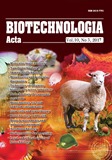ISSN 2410-7751 (Print)
ISSN 2410-776X (on-line)

"Biotechnologia Acta" V. 10, No 3, 2017
https://doi.org/10.15407/biotech10.03.065
Р. 65-71, Bibliography 10, English
Universal Decimal Classification: 631.46.631.445.41:631.84
National Scientific Center “Institute of Agriculture of the National Academy of Agrarian Sciences of Ukraine”, Chabany, Ukraine
The aim of the work was to determine the possibility of using the number and activity of Azotobacter cells and melanin-synthesizing micromycetes as indicators of gray forest soils of different types (fallow, extensive and intensive agrosoil) pollution with heavy metal ions. For this purpose, there were used laboratory-analytical, microbiological and statistical methods. As a result of research of increasing doses of heavy metals (zinc + lead) influence on the number of microorganisms in the gray forest soils it was found that the number and activity of Azotobacter and the number and part of melanin-synthesizing micromycetes in their total number may be fit into indicators of pollution with heavy metals. Azotobacter cells activity index may be considered indicative at contamination levels of 5-100 of maximum permissible concentrati{spoiler title=Скрытый текст}{/spoiler}on in the absence of vegetation, at contamination levels of 10–100 – for soils with phytocenosis. The number and proportion of melaninsynthesizing micromycetes in total guantity may serve as diagnostic sign of gray forest soils pollution with high doses of heavy metals, but only for the period of contamination up to 2 years.
It was shown that nature of the effect of heavy metals on the number of microorganisms of indicative groups depended on the presence of plants in the monitoring system, on doses of heavy metals, on the term of contamination and on the type of soil usage.
Key words: Azotobacter, melanin-synthesizing micromycetes, diagnostic indicator, pollution, heavy metals.
© Palladin Institute of Biochemistry of National Academy of Sciences of Ukraine, 2017
References
1. Bernard L., Maron Р., Mougel С., Nowak V., L?v?que J., Marol C., Balesdent J., Gibiat J., Ranjard L. Contamination of soil by copper affects the dynamics, diversity, and activity of soil bacterial communities involved in wheat decomposition and carbon storage. Appl. Environ. Microbiol. 2009, 75 (23), 7565–7569.
2. Anderson J., Hooper М., Zak J., Cox S. Characterization of the structural and functional diversity of indigenous soil microbial communities in smelter-impacted and nonimpacted soils. Environ. Toxicol. Chem. 2009, 28 (3), 534–541.
3. Mosina L. V. Features of microbial components functioning in a soil-plant system in conditions of high soil contamination with heavy metals and unregulated recreation. Proc. TSKhA. 2010, N 282, P. 732–739. (In Russian).
4. Malinovska I. M., Dombrovska I. V. State of microbiota gray forest soils under different using. Visnyk Kyivskoho Natsionalnoho Universytetu. Ser. Biol. 2011, Issue 57, P. 21–25. (In Ukrainian).
5. Selivanovskaya S. Yu., Kiyamova S. N., Latypova V. Z., Alimova F. K. Effect of sedimentary waste water containing metals on microbial cenosis of wood gray soil. Pochvovedeniye. 2001, N 5, P. 588–594. (In Russian).
6. Malinovska I. M., Zinoviev N. A. The direction and intensity of microbiological processes in dark gray ashed soils contaminated with petroleum. Visnyk Poltavskoi derzhavnoi ahrarnoi akademii. 2010, N 4, P. 17–23. (In Ukrainian).
7. Kolosvary I. Data concerning the possibility of using the abundance of the Azotobacter cells as bioindicator of soil pollution. Stud. Univ. Babes-Bolyai. Biol. 1998, N 1–2, P. 137–141.
8. Kozhevin P. A., Kozhevina L. S., Bolotina I. N. Definition of bacteria state in ground. Doklady AN SSSR. 1987, 297 (5), 1247–1249. (In Russian).
9. Bernlohr R. W., Webster G. C. Effect of chloramphenicol on protein and nucleic acid metabolism in Azotobacter agilis. J. Bacteriol. 1958, 76 (3), 233–238.
9. Khovrychev M. P., Semenova A. M., Rabotnova I. L. The action of zinc ions on Candida utilis. Mikrobiol. 1980, T. XIX, V. 1, P. 59–63. (In Russian).
10. Zhdanova N. N., Wasilewskaia A. N. Mushrooms containing melanin in extreme conditions. Kyiv: Naukova dumka. 1988, 196 p. (In Ukranian).

